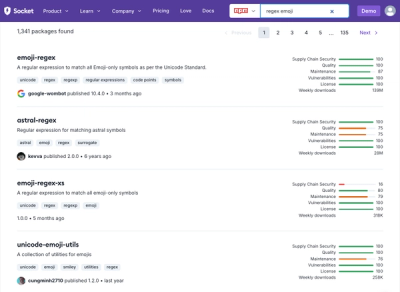
Research
Security News
Malicious npm Package Targets Solana Developers and Hijacks Funds
A malicious npm package targets Solana developers, rerouting funds in 2% of transactions to a hardcoded address.
global-tunnel-ng
Advanced tools
The global-tunnel-ng npm package is used to configure global HTTP/HTTPS proxy settings for Node.js applications. It allows you to route all HTTP and HTTPS requests through a proxy server, which can be useful for various purposes such as accessing resources behind a firewall, anonymizing requests, or debugging network traffic.
Setting up a global proxy
This feature allows you to set up a global proxy for all HTTP and HTTPS requests in your Node.js application. The `initialize` method configures the proxy server's host and port, and optionally, the number of sockets to use.
const globalTunnel = require('global-tunnel-ng');
globalTunnel.initialize({
host: 'proxy.example.com',
port: 8080,
sockets: 50 // optional pool size for sockets
});Disabling the global proxy
This feature allows you to disable the global proxy settings that were previously configured. The `end` method stops routing requests through the proxy server.
globalTunnel.end();Customizing proxy settings
This feature allows you to customize the proxy settings further by providing optional parameters such as authentication credentials, protocol, and tunneling. The `initialize` method accepts these additional options to configure the proxy server as needed.
globalTunnel.initialize({
host: 'proxy.example.com',
port: 8080,
proxyAuth: 'user:password', // optional authentication
protocol: 'https', // optional protocol
tunnel: true // optional tunneling
});The proxy-agent package provides a flexible way to configure proxy settings for HTTP, HTTPS, and other protocols. It supports various proxy protocols such as HTTP, HTTPS, SOCKS, and PAC. Compared to global-tunnel-ng, proxy-agent offers more flexibility in terms of supported protocols and configuration options.
The tunnel package is used to create HTTP and HTTPS agents that route requests through a proxy server. It supports both HTTP and HTTPS proxies and provides options for tunneling. Compared to global-tunnel-ng, the tunnel package focuses more on creating custom agents for specific requests rather than setting global proxy settings.
The https-proxy-agent package is specifically designed to route HTTPS requests through an HTTP or HTTPS proxy server. It provides a simple and efficient way to configure proxy settings for HTTPS requests. Compared to global-tunnel-ng, https-proxy-agent is more specialized and focused on HTTPS requests.
Configures the global
http and
https
agents to use an upstream HTTP proxy.
Works transparently to tunnel modules that use node's default http.request()
method
as well as the popular request module.
You can install this package by just executing the following:
npm install global-tunnel-ng
To make all HTTP and HTTPS connections go through an outbound HTTP proxy:
var globalTunnel = require('global-tunnel-ng');
globalTunnel.initialize({
host: '10.0.0.10',
port: 8080,
proxyAuth: 'userId:password', // optional authentication
sockets: 50 // optional pool size for each http and https
});
This will use the CONNECT method for HTTPS requests and absolute-URIs for
HTTP requests, which is how many network proxies are configured.
Optionally, to tear-down the global agent and restore node's default global agents:
globalTunnel.end();
Any active connections will be allowed to run to completion, but new connections will use the default global agents.
The complete list of options to globalTunnel.initialize:
CONNECT method. It
has three possible values (strings):
CONNECT; just use absolute URIsCONNECT for HTTPS requestsCONNECT for both HTTP and HTTPS requestshttp: or https:.userId:passwordHere's a few interesting variations on the basic config.
Another common proxy configuration is one that expects clients to use an absolute URI for the Request-URI for all HTTP and HTTPS requests. This is common for networks that use a proxy for security scanning and access control.
What does this mean? It means that instead of ...
GET / HTTP/1.1
Host: example.com
... your proxy expects ...
GET https://example.com/ HTTP/1.1
You'll need to specify connect: 'neither' if this is the case. If the proxy
speaks HTTP (i.e. the connection from node --> proxy is not encrypted):
globalTunnel.initialize({
connect: 'neither',
host: '10.0.0.10',
port: 3128
});
or, if the proxy speaks HTTPS to your app instead:
globalTunnel.initialize({
connect: 'neither',
protocol: 'https:',
host: '10.0.0.10',
port: 3129
});
If the proxy expects you to use the CONNECT method for both HTTP and HTTPS
requests, you'll need the connect: 'both' option.
What does this mean? It means that instead of ...
GET https://example.com/ HTTP/1.1
... your proxy expects ...
CONNECT example.com:443 HTTP/1.1
Be sure to set the protocol: option based on what protocol the proxy speaks.
globalTunnel.initialize({
connect: 'both',
host: '10.0.0.10',
port: 3130
});
EXPERIMENTAL
If tunnelling both protocols, you can use different HTTPS client configurations for the two phases of the connection.
globalTunnel.initialize({
connect: 'both',
protocol: 'https:'
host: '10.0.0.10',
port: 3130,
proxyHttpsOptions: {
// use this config for app -> proxy
},
originHttpsOptions: {
// use this config for proxy -> origin
}
});
If globalTunnel.initialize doesnt receive a configuration as its first parameter the http_proxys and http_proxy environment variables will be used.
If these are missing the npm configurations https-proxy, http-proxy, proxy will be used instead.
If no environment variables or npm configurations are found nothing will be done.
As the module does some extra job determining the proxy (including parsing the environment variables) and does some normalization (like defaulting the protocol to http:) it may be useful to retrieve the proxy URL used by the module.
The property globalTunnel.proxyUrl is the URL-formatted (including the optional basic auth if provided) proxy config currently in use. It is null if the proxy is not currently enabled.
Similarly, the globalTunnel.proxyConfig contains the entire parsed and normalized config.
The property globalTunnel.isProxying contains the information about whether the global proxy is on or off.
Any module that doesn't specify an explicit agent: option to
http.request
will also work with global-tunnel.
The unit tests for this module verify that the popular request
module works with global-tunnel active.
For untested modules, it's recommended that you load and initialize
global-tunnel first. This way, any copies of http.globalAgent will point to
the right thing.
If you'd like to contribute to or modify global-tunnel, here's a quick guide to get you started.
Download via GitHub and install npm dependencies:
git clone git@github.com:np-maintain/global-tunnel.git
cd global-tunnel
npm install
Testing is with the mocha framework.
Tests are located in the test/ directory.
To run the tests:
npm test
As this is a hard fork, you may still contact the given contacts below.
Email GoInstant Support or stop by #goinstant on freenode.
For responsible disclosures, email GoInstant Security.
To file a bug or propose a patch, please use github directly.
© 2014 GoInstant Inc., a salesforce.com company
Licensed under the BSD 3-clause license.
FAQs
Global HTTP & HTTPS tunneling
We found that global-tunnel-ng demonstrated a not healthy version release cadence and project activity because the last version was released a year ago. It has 1 open source maintainer collaborating on the project.
Did you know?

Socket for GitHub automatically highlights issues in each pull request and monitors the health of all your open source dependencies. Discover the contents of your packages and block harmful activity before you install or update your dependencies.

Research
Security News
A malicious npm package targets Solana developers, rerouting funds in 2% of transactions to a hardcoded address.

Security News
Research
Socket researchers have discovered malicious npm packages targeting crypto developers, stealing credentials and wallet data using spyware delivered through typosquats of popular cryptographic libraries.

Security News
Socket's package search now displays weekly downloads for npm packages, helping developers quickly assess popularity and make more informed decisions.